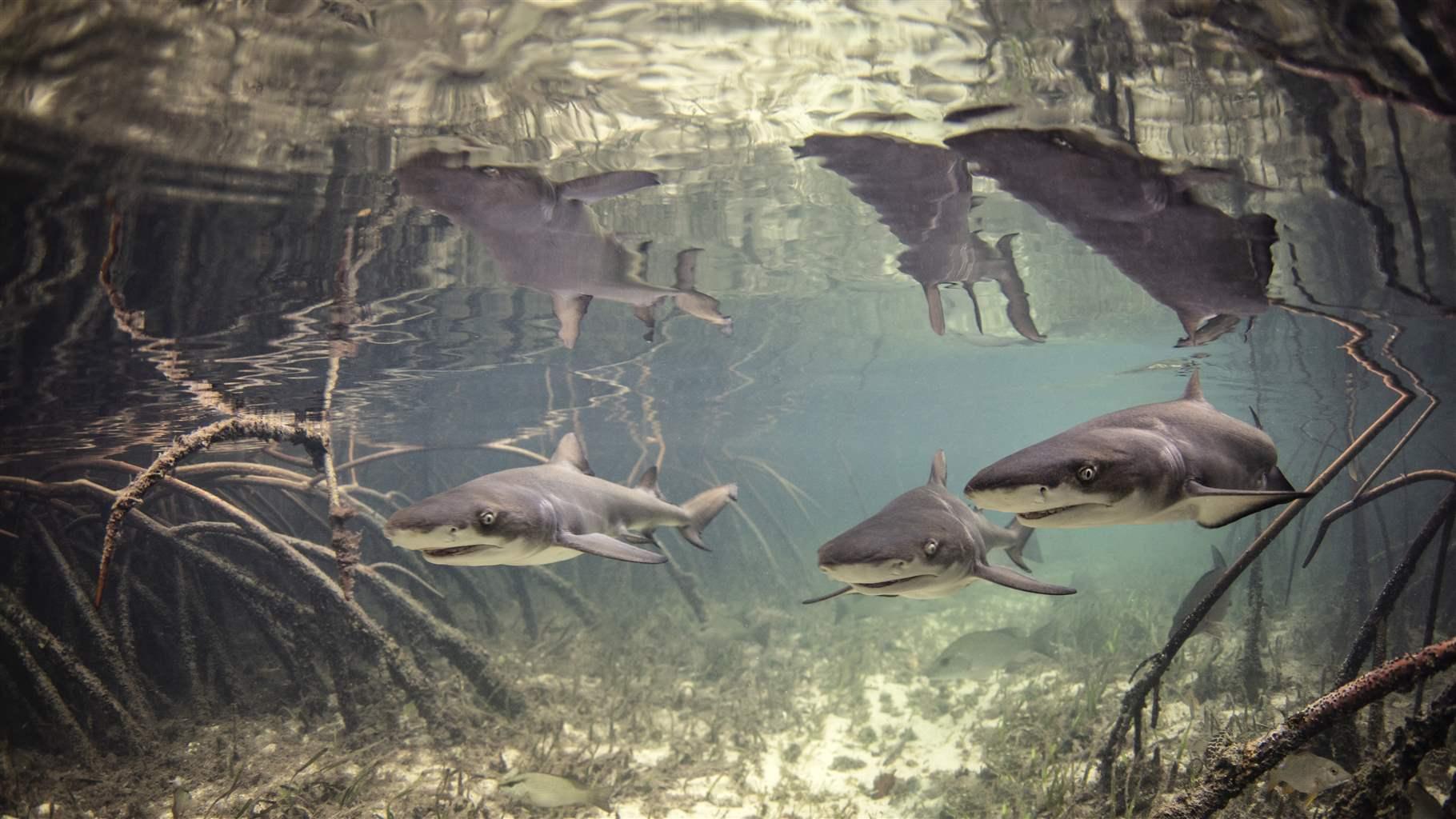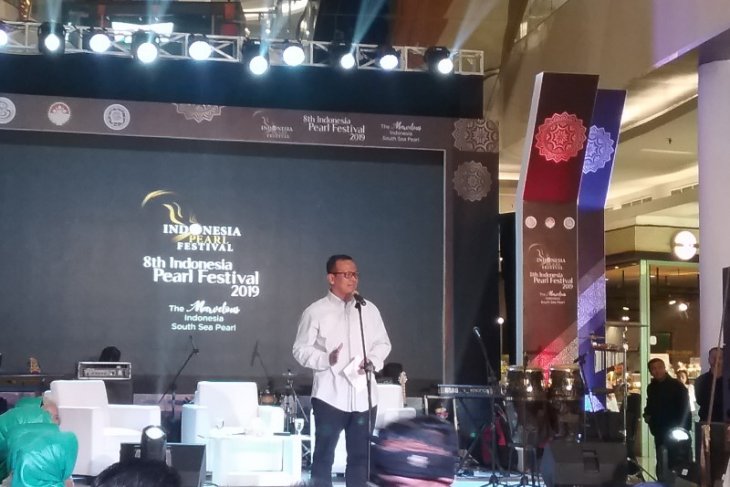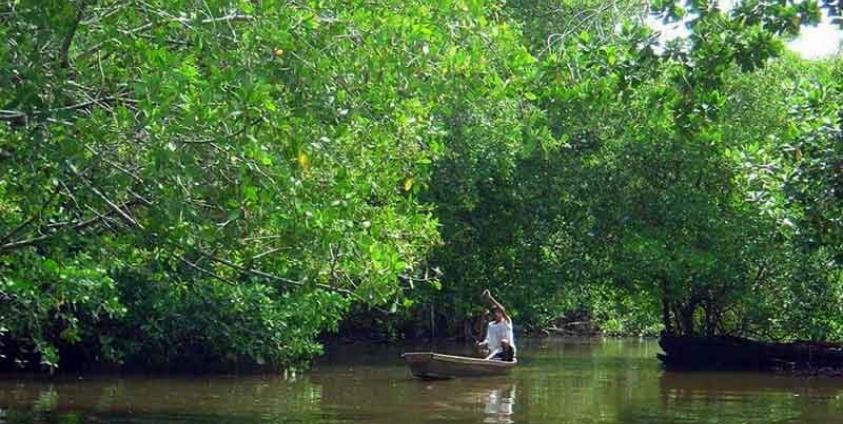FEATURE MAP CELEBRATES ITS 500th Edition of MAP NEWS (Formerly Late Friday News)

USA – An extension of the MAP Quartlerly Newsletter (a hand addressed snail-mailed paper product of the last century), MAP’s electronic version, The Late Friday News, marks it’s 500th issue with this post. Starting in 2000, the Newsletter has faithfully gone out to MAP News subscribers around the world every other week. To celebrate the 500th issue, we take a look at some of the tremendous growth and progress Mangrove conservation and restoration have seen. When MAP was founded in 1992, the goal was to bring awareness to global need to protect tropical coastal forests for protection against cyclones, the benefit of global fisheries, coral reef health and the continuation of thousands of years of traditional livelihoods. Today, some 28 years after MAPs founding, the awareness of the importance of mangrove ecosystems is well recognized on a global scale. But they still remain under serious threat. READ MORE GLOBAL WORLD MANGROVE DAY PHOTOGRAPHY AWARDS 2020

GLOBAL – Welcome to our 6th World Mangrove Day! Once again as a celebration of World Mangrove Day we are harnessing the power of photography to raise awareness of mangrove forests and we are proud to share these amazing photos with you! This incredible collection of images celebrates the work of all our mangrove photographers. Our 2020 contest has been our most exciting yet, with entries from all over the world showing the true beauty and importance of mangrove ecosystems. Come and view our biggest mangrove online exhibition ever. We were inspired this year by the bold commitments being made across the world for a sustainable future and with our four brand new categories we hope to inspire action for Nature. Our categories highlight mangrove wildlife, communities, conservation, and the threats that mangrove forests are facing. READ MORE
VIEW GALLERY Mangrove Protections Can Provide Conservation Wins

GLOBAL – On July 26, we celebrate International Day for the Conservation of the Mangrove Ecosystem and take the opportunity to highlight why mangrove forests are some of the most valuable ecosystems on our planet. Mangroves range from shrubs to trees—some only a modest 3 meters (10 feet) tall, while others grow to a towering 40 meters (131 feet) or higher. And although species of mangroves within a forest may not be genetically related, they share common characteristics. Their unique biology enables them to thrive in a wide variety of conditions that most other trees would find toxic. They tolerate both high and fluctuating salinity and take root in salty, low-oxygen soils. This makes them ideally suited for the ever-changing coastal environment. The inclusion of mangrove protections in climate policy can be a triple win for countries, strengthening communities’ efforts to adapt to changing environments, mitigating the effects of climate change, and helping to build resilience. READ MORE AFRICA In Tanzania, locals and officials band together to save mangroves

TANZANIA – In the lead up to International Day for the Conservation of the Mangrove Ecosystem on 26 July, United Nations Environment Programme (UNEP) is running a series of stories on mangroves, and their impact on the environment and economies of countries across the world. For many of the 30,000 people who live in the remote Rufiji Delta of northern Tanzania, life revolves around one thing: mangroves. These trees and bushes, which thrive in the delta’s brackish water, are sources of building materials, firewood and income, providing valuable timber that residents often sell to make ends meet. But the mangroves, which are also home to many species, like ray fish, hongwe, migratory birds and sea turtles, are sometimes seen as obstacles to be cut down, occupying land that can be used to grow rice and graze livestock. Such over-dependence on mangroves in the Rufiji Delta, home to 50 per cent of Tanzania’s mangroves, has led to a depletion of these forests, threatening residents’way of life. READ MORE AMERICAS WANTED: Mangrove Rangers

CAYMAN ISLANDS – The Mangrove Education Project is seeking a few good Caymanians for its Mangrove Ranger programme. The non-profit organisation is set to launch the new initiative on July 26 as Cayman prepares to mark World Mangrove Day. Martin Keeley, executive director of the Mangrove Education Project in Cayman, said that the Mangrove Ranger programme was borne out of a need to educate and protect the vital habitats around the islands. He said Cayman’s mangrove destruction is worrying, as he has seen the country move from development to overdevelopment.”We have seen a major loss of mangrove all over the islands,” Keeley said in a telephone interview with the Cayman Compass recently. “The idea is to be able to monitor what is going on and to establish a baseline data on mangroves around the island because, at the moment, there is very little data, and so we need to establish that. READ MORE Fight against shrimp that eats mangroves

USA – Close your eyes and imagine some wetlands with magical trees, with huge roots that come out of a gray, half-swampy ground. A place that is right where freshwater and saltwater meet: where there are canals to navigate, manatees, crocodiles, monkeys and many species of birds. Those are the mangroves ”. This is how Mónica Gutiérrez Quarto, a Chilean artist who now lives in the United States, describes one of the ecosystems to which she has dedicated part of her work. As a member of the Mangrove Action Project (MAP) team, an initiative founded by her husband Alfredo Quarto, she uses art to educate children around the world about mangroves: one of the most important forests for climate change. Although little is said about them, mangroves are full of stunning properties. They serve as natural barriers to prevent soil erosion, protect coastal communities from hurricanes, and are the place where fish breed. READ MORE Mangrove forest restoration boosts Costa Rica communities

COSTA RICA – Twenty years ago, I collected between 600 to 800 a day – now I’m lucky if I can harvest 150.” Adrian Torres holds a black, shining, wrinkled mollusk (Anadara tuberculosa) the size of a small chicken egg. It is known as the “mud cockle,” or here along Costa Rica’s Pacific coast, as the piangua. That’s why Adrian and the members of his community association, Ajuntaderas, are known as the “piangueros” – the mud cockle collectors. They live within the Terraba Sierpe National Wetland, one of the largest protected wetlands in Central America. For as long as Adrian can remember, his community – and others living nearby – have depended upon the harvest of this gothic looking shellfish to make their living; a practice that replaced the harvesting of timber from the wetland’s mangrove trees. READ MORE ASIA Towards innovative, conflict-sensitive and human rights-based approaches to forest monitoring

MYANMAR- The Governments of Myanmar and Finland today launched a trailblazing project designed to allow for monitoring of forests in a manner that is sensitive to local conflicts and protects human rights. The five-year project will be led by the Food and Agriculture Organization of the United Nations (FAO) thanks to a EUR 8 million endowment from the Government of Finland, a consistent partner in the promotion of environmental sustainability. The project is innovative in taking a conflict sensitive and human rights-based approach to forest monitoring. This has global relevance as it will provide insights into how to bolster sustainable forests in other fragile countries affected by conflicts that are frequently exacerbated by disputes over tenure and access to natural resources. “Actions to monitor and measure Myanmar’s forests have great potential to deliver benefits for multiple purposes. READ MORE Mangrove forests to hereafter not be converted into ponds: Minister

INDONESIA – Maritime Affairs and Fisheries Minister Eddhy Prabowo has made assurance that mangrove forests would henceforth not be converted into ponds, and the ministry, in its place, plans to plant more mangrove trees. “I guarantee that there will be no more deforestation of mangrove forests in future. In its place, we will plant mangroves,” Minister Prabowo noted in a statement recently. A new-fangled innovative aquaculture system has been developed that enables shrimp and fish farming without the need to have a vast land area, he remarked. Hence, mangrove trees would no longer have to be cleared to make way for shrimp or fish ponds, he explained. The Ministry of Maritime Affairs and Fisheries has been developing an innovative intensification system for shrimp farming and fish ponds. READ MORE Meet Indonesia’s carbon guardian
:no_upscale()/cdn.vox-cdn.com/uploads/chorus_asset/file/19482505/DJI_0911.jpg)
INDONESIA – Indonesia’s mangroves are an incredibly effective tool against climate change — but they’re being cut down to grow shrimp and palm oil for you. Large-scale palm oil production is one of the biggest drivers of deforestation in Indonesia; tens of millions of acres of primary rainforest, peatlands, and coastal lowlands have been cleared to grow the oil-rich fruit for fuel, food, and household products for consumers around the world. Palm oil was also responsible for most of the fierce fires that burned more than 2,500 square miles in Indonesia this year; some 80 percent of the fires were set to clear land for the crop, officials told the New York Times. Unless the country can dramatically slow down mangrove destruction, one of Indonesia’s best climate assets will end up only accelerating the emergency. READ MORE Mangroves and Khazan agriculture: Sustaining Goa’s promise for fish, curry and rice

INDIA – Although the Khazan lands had a diverse set of owners which included government, religious bodies, private holders, the most dominant form of Khazan land tenure pre-1961 was that of the Communidades. These were community lands collectively owned and managed by the Communidade of a given area. Their management involved a number of tasks which included the construction, maintenance and operation of bunds and sluice gates, the leasing of farming and fishing rights and instituting penalties for the breach of rules among many others Today, for various reasons, but primarily due to post-independence agrarian reforms of 1961, these lands largely lie fallow and are in a state of decay. Lack of cultivation and maintenance of the bunds and sluice gates is leading to their breaching and the natural reclamation of these fallow lands by mangroves. READ MORE Save Maldives pledges to save Neykurendhoo wetlands on Mangrove Day

MALDIVES – On the occasion of the International Day for the Conservation of Mangrove Ecosystems, Save Maldives reaffirmed the campaign’s efforts to save the withering wetlands of Neykurendhoo, Haa Dhaalu Atoll. The death and decay of Neykurendhoo’s mangroves were first observed in March, prompting the island council to bring the matter to the attention of relevant authorities. Neykurendhoo’s wetlands were designated a protected environmental site in December 2018 and are among the largest and most ecologically rich mangrove ecosystems in the country, in addition to being an important food source for the people of the region. “On this International Day for the Conservation of Mangrove Ecosystems, we wish to inform the public of the critical importance of mangroves to the Maldives and to highlight the fact that the Maldives is a mangroves nation with many of our islands protected and served by wetlands and mangrove ecosystems”, a statement publicised by the collective read. READ MORE Mangrove conservation up against socioeconomic realities of forest resources

MYANMAR – Arakan State residents are deleteriously cutting down mangroves growing along the state’s coast to earn a living, say organisations working to conserve the valuable shoreline forests. Mangroves are deforested to sell firewood for brick-making fields and to make charcoal, said Ko Myo Lwin, a leader of the Ann Township Mangrove Trees Conservation Group. “Villagers find it difficult to get a job for their living. Additionally, COVID-19 is one of the factors creating hardships for their living. That’s why some residents rely on mangrove forests for income,” said Ko Myo Lwin. The current socioeconomic trends require that mangrove forests be conserved, he added. READ MORE LAST WORD Dear MAP, Because this is our home, any degradation to this planet affects every living being today and tomorrow. MAP has dedicated its energies, resources, and mission to educate the people of this beautiful earth about the place mangroves have in our lives And the role they play in protecting human habitation and sustaining wildlife. Supporting this fine organization is my way of wrapping my arms around the world it strives to protect and honor. Thank you Mangrove Action Project for over a quarter-century of dedication! Francesca Quarto-Mohan
Like this newsletter?
Pease consider donating to MAP to keep it going.
Giving could never be easier | 2021
CHILDREN’S ART CALENDAR
PREORDER NOW
ENTRIES NEEDED!  Singing for the Sundarbans WATCH HERE Entrevista con Monica Quarto del Mangrove Action Project (Spanish language) Oye Aqui ACTION ALERTS Please SIGN: keep plantations out of orangutan habitat!
TAKE ACTION Unilever: stop destroying mangroves for convenience food! SIGN OUR PETITION Stop plundering the oceans for industrial aquaculture! SIGN THE PETITION Take action now and stop the build-out of coal plants in Bangladesh. Save Kakinada mangrove forest – Sign the Petition Like this newsletter? Pease consider donating to MAP to keep it going. Giving could never be easier CBEMR Training in Tanzania: Ground-breaking training breathes life into mangrove ecosystem restoration – The Mangrove Alliance Please see our newest video: ” Restoring The Natural Mangrove Forest” – https://youtu.be/Vh7CoPBLQa8 Mangrove Restoration Map VIEW MAP HERE 
Restoring The Natural Mangrove Forest
Watch movie 
Community Based Ecological Mangrove Restoration in Rufiji Delta VIEW VIDEO Video: Mangroves for the Future – A look bacK. As the latest phase of Mangroves for the Future (MFF) draws to a close, this video highlights some of the project’s most successful initiatives – from local women supporting national park management in Viet Nam to an island in the Maldives that has become a model for waste management, and everything in between. View Here WANT TO GET INVOLVED?
Follow and Join MAP!    
Like this newsletter? Pease consider donating to MAP to keep it going. Giving could never be easier  
VOLUNTEER OPPORTUNITY 
MANGROVE ISSUES Want to learn more about mangroves?
Our short presentation will give you a better understanding of the issues we are working to solve. WATCH PRESENTATION What is CBEMR? Download MAP’s 2 page CBEMR Information Sheet containing links to all MAP’s CBEMR resources – CLICK HERE What is EPIC? – The Ecosystems Protecting Infrastructure and Communities (EPIC) project: the role of ecosystems as protective barriers against climate induced hazards MANGROVES APP AVAILABLE
A pictorial field guide for easy identification of various mangrove species and learning about the mangroves ecosystem. CLICK HERE View MAP’s uploaded Videos at MAPmangrover’sChannel
Question Your Shrimp Consumer/Markets Campaign!
WATCH VIDEO WATCH – Mangroves: how they help the ocean
 Mangrove Restoration in Asia – Watch Short Video The Value of Mangrove Forests View Video CBEMR Experience Exchange MAP 2017 English Subtitles
VIEW THE VIDEO Mangroves: Guidebook to Malaysia – Click Here
Mangrove rehabilitation in Asia – Local Action and cross-border Transfer of Knowledge for the Conservation of Climate, Forests and Biodiversity VIEW VIDEOS HERE SHARE MAP’S VISION
CLICK HERE to watch short introductory video. Together we can work “at the roots of the sea”. Our short documentary, Reducing the Risk of Disaster through Nature-Based Solutions : Mangroves

INTERVIEW – Yale Climate Connection interview with MAP’s Alfredo Quarto LISTEN Exclusive Interview with Alfredo Quarto, Co-Founder and Executive Director of Mangrove Action Project – See more
Marvellous Mangroves Curriculum The Marvellous Mangroves Education Forum is an online hub for those utilizing the Marvellous Mangroves (MM) Curriculum. It gives students, teachers and anyone interested in mangroves, the opportunity to learn and share ideas themed around the curriculum, to connect and communicate with others around the globe whilst exploring mangroves from your computer or on the go. VISIT 
The award-winning Marvellous Mangroves (MM) curriculum educates children on the importance of mangroves and their ecological functions, teaching them about modern challenges and mechanisms for sustainability. VIEW VIDEO Marvellous Mangroves Curriculum in Bangladesh – WATCH VIDEO
MARVELLOUS MANGROVES IN BRAZIL
En Portuges 
Marvellous Mangroves – A Curriculum-Based Teachers Guide. FOR MORE ON MAPs AWARD WINNING CHINA MANGROVE CURRICULUM VISIT

VIMEO SHOW
VISIT OUR “MM” WEBPAGE Check out our presentation for more details on Marvellous Mangroves Read this 10 page history of the development of MAP’s educational curriculum VIEW DOCUMENT
Article in Canada’s Green Teacher Magazine – Read More
Like this newsletter? Pease consider donating to MAP to keep it going. Giving could never be easier  Green Planet Fundraising Assists MAP – LEARN MORE
Volunteer Opportunities with Mangrove Action Project CLICK HERE
“Question Your Shrimp” Campaign Question Your Shrimp- Don’t Buy or Sell Imported Tropical Shrimp! Sign the Petition Learn more about the affects of the shrimp industry on mangroves by visiting our blog
Editor’s Note: Mangrove Action Project’s Executive Director, Alfredo Quarto was interviewed about shrimp by Green Acre Radio’s Martha Baskin
LISTEN TO INTERVIEW Sign the Consumer’s Pledge to avoid imported shrimp
Not yet a MAP News subscriber?
Click here to subscribe. Note to Our Readers: We strive to keep active links in our newsletter. However, due to circumstances beyond our control, occasionally links to stories may become broken. If you find a link to a story is not functioning, please cut and paste the headline into your browser search bar. In most cases you should be able to locate the original story.
|












:no_upscale()/cdn.vox-cdn.com/uploads/chorus_asset/file/19482505/DJI_0911.jpg)
















